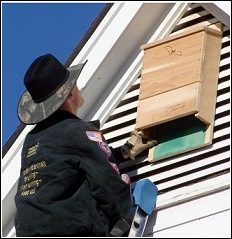Wildlife Control Products
Products That Can Help
There are several products for structures and houses that once installed correctly can provide effective protection from nuisance wildlife.
Whether or not a particular product will work in your particular situation will depend on a variety of variables including how it's applied, weather and many other factors. The Wildlife Whisperer, Inc. can work with you to develop a prevention strategy and help you install the proper products.
Wildlife Barriers
Barriers are a great way to keep animals from getting into your home and from digging underneath foundations. Effective wildlife control products like Dig Defence®, co-developed by Wildlife Whisperer Ned Bruha, help prevent animals from getting under decks, fences, slabs and homes. They can even help keep dogs from digging out of the yard.

There are also dog door products that help keep unwanted wildlife out and guards to keep squirrels off of power lines. And weep hole covers are a great way to keep snakes and mice out of the house and garage.
Barriers such as hardware cloth go a long way when it comes to preventing wildlife problems. Sometimes it's simply a matter of using a different kind of product than what you already have, i.e., a different kind of roof or laundry vent cover or pet door. Barriers are some of our favorite prevention products for homes, barns and commercial properties.
Animal Repellents
One of the first things that comes to mind when wildlife problems arise is how to repel or drive away the wildlife in the first place. There are several humane wildlife repellents on the market today that we particularly like, however, please remember that their effectiveness will depend on several factors, so their success will vary from situation to situation
It is also important to understand the difference between deterrents and repellents. Sadly, every once and a while, there is a situation that due to affordability can only be taken care of with a good quality repellent.
Conservation Products
Some of our favorite products not only help prevent nuisance wildlife inside your home but they can actually help conserve wildlife on the outside too. Conservation products such as Bat Boxes and the Frog Log help make your home and surrounding environment a place where you and certain beneficial wildlife species can live together safely in harmony.

For instance, man made shelters such as bat boxes help keep bats out of your home by giving them an alternate source of shelter so they won't be as tempted to make a home out of your attic. Bats are also a great way to help control mosquitoes around your property.
Books, Videos And Other Educational Sources
Books may not be a physical wildlife barrier for your property but the education they and other sources of information can provide may be just what you need to keep wildlife out. Knowledge can be a powerful tool.
We've put together a list of books, video links, movies, study results and more to help you understand what truly humane wildlife control is all about - why we believe in it and why we do things the way we do.
Some cover topics and products in a humorous manner where others may be difficult for some to watch or read, but all of them come with an important message in mind.

Difference Between Deterrents & Repellents
Often these two words are used interchangeably, incorrectly or not, and their meanings are similar. In other words, you can't always count on an item description to be grammatically correct as to which word is used to describe a particular product's function or design.
Some products could even be classified in more than one category, depending on how you want to look at them. But, just for fun let's look at the subtle differences between the words with respect to wildlife control.
A deterrent, which is the noun equivalent of the verb deter, could basically be considered something that blocks, delays or discourages something an animal may want to do.
A wildlife "barrier" attached to your structure such as a vent guard or weep hole cover would fall into this category because it blocks and/or delays the animal's ability to enter your home.
A repellent, which is the noun equivalent of the verb repel, would be something the animal encounters that it actually finds unpleasant to the senses, often to the point of driving them away.
Yard Guard products are a good example of something that is both a repellent and a deterrent, they make a sound that wildlife find annoying and the animal will usually leave the area to get away from it. By driving the animal away you are discouraging them from proceeding forward, thereby putting the product into the deterrent category. Another good example would be the motion activated water sprays often found in flower beds and gardens, which also deter by driving the animal away.

As the above boolean diagram shows, for the most part, a repellent could be considered a deterrent, but not all deterrents are repellents.
Please note: the word repellant is listed in many dictionaries as an alternate spelling for repellent, so for the most part when it comes to wildlife products these two words can be considered as one in the same.
1242 SW Pine Island Rd., Suite 310
Cape Coral, Florida 33991-2126
help@totalwildlifecontrol.com


















